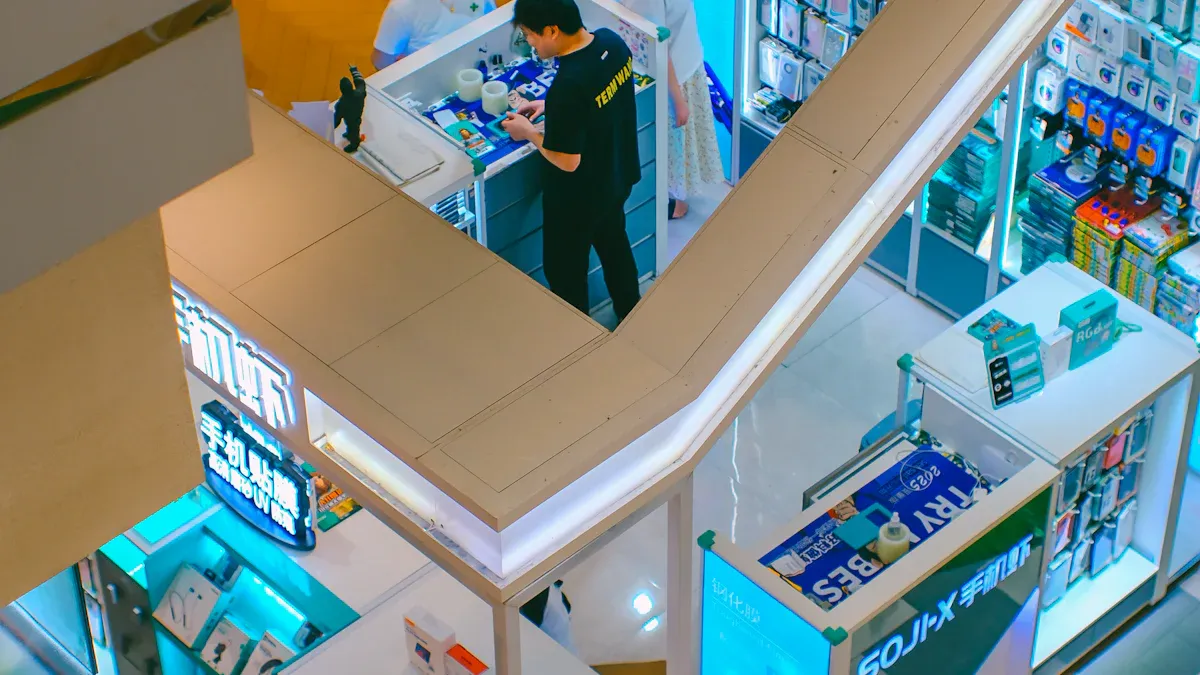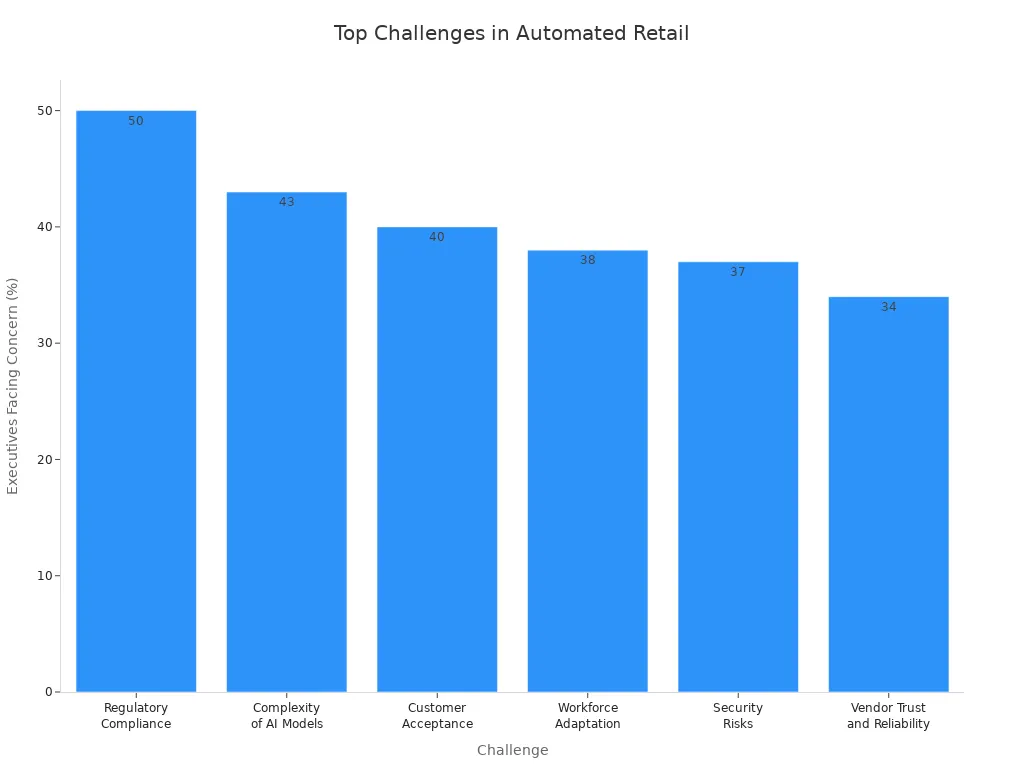2025 Insights on Automated Retail Transformation in Asia and Europe

You can see automated retail transformation moving very fast in Asia and Europe. The market is growing quickly, especially in Asia Pacific. Here, markets grow at a 12.1% CAGR.
The global retail automation market could reach USD 30.51 billion by 2025.
By 2029, it may reach USD 44.3 billion.
AI, robotics, and data connectivity are changing shopping and store work. Here’s how technology affects retail:
Technology | Impact on Retail Operations |
|---|---|
Internet of Things | Shows real-time inventory and customer movement. |
Artificial Intelligence | Gives personal suggestions and predicts what people want. |
Robotics | Does jobs like checking inventory and cleaning. |
RFID | Makes inventory more correct and supply chains stronger. |
Key Takeaways
Automated retail is growing fast in Asia and Europe. The market may reach USD 30.51 billion by 2025. Follow this trend to keep your business strong.
AI and smart checkout systems make shopping faster and easier. Try using these technologies to make customers happier.
Robots and data-driven operations help manage inventory and service. Use these tools to make your store work better and more accurately.
Contactless and self-service technologies make shopping safer and quicker. Use these solutions to help customers and cut down wait times.
Working with local tech firms helps your store use new technology well. Team up with experts to learn about automated retail.
Automated Retail Transformation: 2025 Trends
AI and Smart Checkout
AI and smart checkout are changing shopping in Asia and Europe. Stores use AI to make checkout quick and simple. You can scan items with your phone. You can also use self-checkout kiosks. Some stores, like Amazon Go, let you walk out with your things. Sensors keep track of what you buy. Walmart’s Scan & Go app lets you pay with your phone. These systems update inventory right away. They give you different ways to pay.
The market for AI checkout is growing fast. In Asia Pacific, the value may go from USD 600 million in 2023 to USD 4 billion by 2032. The CAGR is 23.5%. In Europe, the market could reach USD 3.6 billion by 2032. The growth rate is 18.2%.
Region | 2023 Market Value | Projected 2032 Value | CAGR (%) |
|---|---|---|---|
Asia Pacific | USD 600 million | USD 4 billion | 23.5% |
Europe | USD 800 million | USD 3.6 billion | 18.2% |
More stores now use self-checkout kiosks. These kiosks let you scan, bag, and pay for things yourself. Retailers use smart checkout to make shopping faster. You spend less time waiting in line. Shopping feels easier and smoother.
Robotics in Retail
Robots help stores keep track of products and help customers. Robots like Tally and AutoStore use RFID and computer vision to check stock. These robots can be very accurate, up to 99.7%. Humanoid robots, like SoftBank’s Pepper, help you in stores. They suggest products and guide you. Robots also pack orders in warehouses. This makes order packing faster and more correct.
Asia Pacific is ahead in retail robotics. The CAGR is expected to be 37.2% from 2025 to 2031.
Countries like China, Japan, and South Korea use robots to save money on labor and help many stores.
Europe uses robots that work with people in stores. The U.K. and Germany use them a lot. Nordic supermarkets use robots to stock shelves because labor costs are high.
Robots make shopping easier for you. They help staff do more important jobs.
Data-Driven Operations
Stores use data to make shopping better for you. They collect details about what you buy and how you shop. AI helps stores send you special offers and suggest products. You get deals based on what you like and bought before. Stores change prices quickly using dynamic pricing. They use data to keep shelves full and guess what you might want next.
Stores use your shopping habits to make ads just for you.
They change prices when demand or competition changes.
Inventory optimization helps stores keep products in stock.
Big companies like Amazon and Walmart use smart analytics. This helps them have more products and keep customers happy. In Asia Pacific, the AI market is growing fast. Companies like NVIDIA and Microsoft help stores use AI for better service and smoother operations.
Stores use tools like machine learning, computer vision, and natural language processing. These tools help stores manage products, guess demand, and talk to you better.
Contactless and Self-Service
Contactless and self-service tech make shopping safer and easier. You can pay without touching cash or cards. Self-service kiosks let you order food, buy tickets, or check in at hotels. In Europe, about 70% of train stations have self-service ticket machines. In Asia Pacific, more cities mean more self-service technology.
Self-service kiosks at places like McDonald’s help staff do other jobs and make orders more correct.
Many hotel guests like using apps for room service and check-in.
New ATMs with contactless features make customers happier and safer.
Contactless solutions help stores save money and keep things clean. They also help stores make more money. You get faster service and a better experience. Stores need to make kiosks easy to use. If kiosks are hard to use, you might get upset and buy less.
Automated retail transformation in 2025 means you see more AI, robots, data analytics, and contactless tech in stores. These changes help stores serve you better and make shopping easier.
Asia: Innovations and Growth

Disruptive Technologies
Asia-Pacific is ahead in retail innovation. Stores use new technology all the time. Many retailers use AI-driven platforms to make shopping feel personal. You can pay fast with your phone using mobile payment solutions. Voice-based engagement tools help stores learn what you like by listening to your voice.
Technology | Description |
|---|---|
AI-driven platforms | Make shopping more personal for each visitor. Brands change how they interact with you. |
Mobile payment solutions | Turn Android devices into payment terminals. This makes paying faster and saves money. |
Voice-based engagement | Use voice notes instead of surveys. Stores get better feedback and customers stay loyal. |
Showrooming and Click-and-Collect
Mobile technology lets you shop in new ways. Many people look at products in stores using their phones. Then, they buy online. This is called showrooming. You can also order online and pick up at the store. This is click-and-collect. Retailers connect stores with online platforms. You get more choices and ways to shop. Automated retail transformation helps you switch between online and store shopping easily.
Market Drivers
Many things help automated retail transformation grow in Asia:
E-commerce and omnichannel retailing grow fast. More people use smartphones and have internet.
Cities are getting bigger and smarter. In 2023, 63% of people in Asia Pacific lived in cities. Stores use new technology to keep up.
Stores want to work better and faster. They use smart payment systems and IoT devices to make shopping easier.
Regional Case Studies
China is a leader in mobile payments and smart stores. You can pay with your phone almost everywhere. Japan uses robots in stores to help you find things and answer questions. South Korea builds smart stores with AI and self-service kiosks. These countries show how Asia-Pacific leads the future of shopping. Every year, you see more technology in stores.
Europe: Efficiency and Regulation

Integration of Hardware and Software
European stores want to work better and faster. They use hardware and software together to help you shop. Stores use sensors, AI, and smart devices to track items. These tools also make checkout quicker for you. The table below shows how these technologies help:
Technology Type | Functionality |
|---|---|
POS Systems | Faster checkout, better inventory, and more customer help. |
Self-checkout Systems | Lets you pay by yourself, so lines are shorter. |
RFID and Barcode Scanners | Makes inventory more correct and helps supply chains work better. |
Software | Manages devices, looks at data, and helps with customer service. |
You wait less in line and stores keep shelves full. Stores save money and help you more.
Consumer Behavior Shifts
People change how they shop as technology grows. Many like shopping online and in stores. Some pick up orders at service points or use parcel lockers. Fewer people want home delivery now. Stores notice this and use more automation to help you.
Stores use more AI and automation
More people pick up orders outside their homes
Generative AI helps stores talk to you in new ways. You get special offers and faster help.
Regulatory Impact
There is a debate about rules and new technology. Some say EU digital rules slow down new ideas. Others think this is not true. A report by Mario Draghi said Europe’s rules make it hard to keep up with the US and China.
Rules can slow down new tech, but they keep you safe. Stores must follow these rules when using new systems.
Regional Case Studies
France shows good examples of automated retail. Logilec made order fulfillment five times faster. Renault Group cut order time from 120 to 15 minutes. E.Leclerc made drive-throughs 70% faster and doubled orders. Carrefour gives two-hour grocery delivery and changed its system in six weeks.
Company | Country | Key Achievement |
|---|---|---|
Logilec | France | Made fulfillment five times faster with automation. |
Renault Group | France | Cut order time from 120 to 15 minutes. |
E.Leclerc | France | Made drive-throughs 70% faster and doubled orders. |
Carrefour | France | Offers two-hour grocery delivery. |
Carrefour | France | Changed grocery fulfillment in six weeks. |
You see how stores in Europe use technology to fix problems and help you more.
Challenges in Automated Retail
Legacy System Integration
Many stores still use old computer systems. These old systems can slow down new technology. Adding new tools is hard and causes problems.
Older systems have one big design. This makes updates hard and costs more.
Many use old programming languages. Few people know how to fix them.
Data sits in different places. It is hard to see everything or decide fast.
Old systems look clunky and are not easy to use. This frustrates you and store workers.
Security features may be missing. Hackers can get in more easily.
Not many experts know these old systems. It is tough to keep them working.
Stores with old systems fall behind stores with new tech.
Changing everything at once costs a lot and is risky.
You need to plan well when mixing old and new systems. Good planning helps you avoid big problems and keeps your store running.
Workforce and Skills
Automated retail needs new skills. You and coworkers must learn to use new machines and software. Stores spend money on training programs. These programs teach you technical and people skills.
Evidence Description | Key Points |
|---|---|
Investment in Upskilling Platforms | Stores spend more on training to keep up with digital changes. |
Importance of Soft Skills | You learn how to talk to customers and solve problems better. |
Regional Differences | In Europe, stores train workers to meet rules and fill job gaps. |
Growth in Asia | Asia builds more training programs as cities and stores grow fast. |
Security and Privacy
Automated stores collect lots of data. This brings new risks. You must watch out for cyber threats. Some common dangers include:
Threat Type | Description |
|---|---|
Hackers trick you into sharing passwords or clicking bad links. | |
Malware infiltration and data theft | Bad software can steal your personal data, often through other programs. |
Ransomware encryption and demands | Criminals lock your data and ask for money to unlock it. |
DDoS attacks for service disruption | Too much fake traffic can shut down websites and stop sales. |
Web app vulnerabilities for data theft | Hackers find weak spots in online stores to steal information. |
Social engineering manipulation | Scammers use fake stories to get you to share private details. |
You must stay alert and use strong security steps. This protects your data and your store.
Cost and Scalability
Automated retail can save money, but it also brings new costs. You may need to spend more at first for machines and software. Manual work at checkout takes more time and money. Automation helps you save by cutting down on manual tasks.
Aspect | Details |
|---|---|
Increase in Operating Costs | Manual work at checkout raises costs and uses more staff. |
Benefits of Automation | Automation lowers costs and makes work faster and easier. |
Scalability Issues | Manual systems make it hard to grow your business quickly. |
You need to balance the cost of new tech with savings. Planning helps you grow your store without wasting money.
Opportunities and Strategies
Local Partnerships
Working with local partners helps stores use new technology. These partnerships make stores better and faster.
Neurowatt teamed up with Tedia and Viettel in Vietnam.
They work together to bring smart retail and AI to stores.
Stores change from old ways to smart systems with this teamwork.
Local partners help solve problems quickly and share new ideas.
Tip: Pick partners who know your market well. They should help you use technology the right way.
Scalable Tech Investments
You should choose technology that grows with your store. Good investments make your store work better and get ready for the future.
Strategy | Description |
|---|---|
Easy systems help you and your team use new tools. | |
Utilise Computer Vision for Inventory | Tracks products and lets you shop without cashiers. |
Integrate Artificial Intelligence | Gives customers special offers and helps you talk to them. |
Optimise Supply Chain with Autonomous Vehicles | Uses drones and electric vans to deliver things faster. |
Deploy Smart Shelves and Electronic Labels | Changes prices and product info quickly, saving you time. |
Enable Contactless Payment Solutions | Lets customers pay fast and keeps your store clean. |
Test new tools before using them everywhere. This helps you avoid mistakes and save money.
Customer Experience Enhancement
Automation helps you give customers a better experience. Smart tools help you know what people want and help them faster.
Strategy | Description |
|---|---|
Anticipate customer needs | Learn what customers want and suggest things they like. |
Intelligent answer engine | Turns questions into helpful talks. |
Predictive AI | Shows products that fit each customer and helps sales. |
24/7 support | Answers questions any time with smart systems. |
Hands-free interactions | Helps mobile users and people with disabilities shop easily. |
Personalized support | Gives advice that fits each customer’s needs. |
End-to-end engagement | Guides customers from shopping to after-sales help. |
Conversational CX toolkit | Uses AI to chat with customers on different apps. |
Saves money by using AI helpers, like Avis did with a 39% cut. |
Regulatory Navigation
You need to follow rules when using new technology. Learn about local laws before you start. This keeps your store safe and builds trust.
Check data privacy laws in your country.
Make sure your systems protect customer information.
Work with experts to learn new rules.
Update your technology when laws change.
You stay ahead when you follow rules and keep your store safe.
Automated retail is changing quickly in Asia and Europe. Automation can do up to 70% of simple jobs. It helps stores work faster and saves money. You get better data and easier shopping. Staff have more time for important tasks.
Automation makes your store run smoother and improves quality.
It helps you make better choices and serve customers well.
There are problems like rules, hard AI, and new skills needed.
Challenge | % of Executives Worried |
|---|---|
Regulatory Compliance | 50% |
Complexity of AI Models | 43% |
Customer Acceptance | 40% |
Workforce Adaptation | 38% |
Security Risks | 37% |
Vendor Trust | 34% |

You can plan your business by looking at these trends. Think about how automation can help your store grow in 2025 and later.
FAQ
What is automated retail?
Automated retail uses technology like AI, robots, and smart kiosks to help you shop. You scan items, pay quickly, and get help from machines. Stores use data to make shopping easier for you.
How does AI improve your shopping experience?
AI learns what you like and suggests products. You get special offers based on your shopping habits. Stores use AI to keep shelves full and prices fair. You spend less time waiting.
Are automated stores safe for your personal data?
Stores use strong security tools to protect your data. You should check if stores follow privacy laws. Always use safe passwords and avoid sharing personal details with strangers.
Will automation replace store workers?
Automation helps workers do important jobs. Machines handle simple tasks. You still see staff in stores. Workers learn new skills to help you better.
How can you benefit from contactless payment?
Contactless payment lets you pay fast without touching cash or cards. You tap your phone or card. This keeps you safe and saves time. Many stores offer this option now.
See Also
The Future of Retail Lies in AI-Driven Stores
Essential Insights on AI-Enhanced Corner Store Growth
Transforming Online Retail Management with AI Tools
Smart Technology: The Revolution of Electronics Vending Machines
